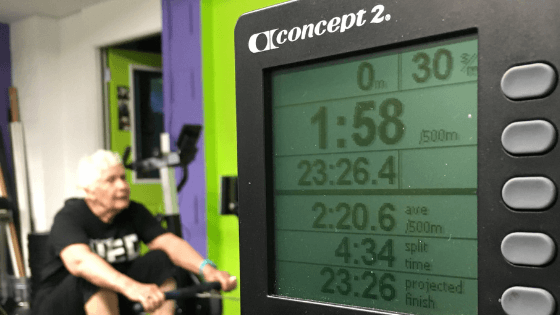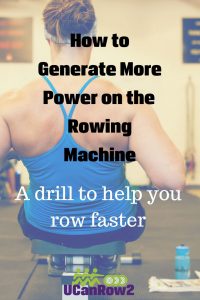Updated Sept. 25, 2018
How’s your rowing workout been lately? Would you like to get more of the benefits of rowing machine workouts? We hear all the time from people who say they’re not performing as well as they’d like. They want to get their times down and their meters up but they’re not sure how to do that.
The difference between a good workout and a great one is in how you apply power on every stroke. That’s true whether your goals are getting a PR on your next 2K, losing 20 lbs. or simply making the most of the time you have on the machine.
In this video, UCanRow2 founder Terry Smythe shows you how to use your monitor to gauge your power output. She also gives you a drill that will help you get faster and stronger on the machine.
Rowing Technique – Generating Power from UCanRow2 on Vimeo.
Key Benefits of Rowing Machine Workouts
- One-stop shopping workout: Rowing is a total-body workout
- Non-impact: It works virtually every muscle on every stroke, with no impact
- It meets you where you are – if you can hold a handle and pull, the rowing machine can probably be modified to fit your needs
- It takes you as far as you want to go – From easy, relaxing rows to some of the toughest competition in sport, the rowing machine is there for you.
- You’re never too old to row: No matter your age, there’s a rowing record in your category, and since the machine is gentle on the joints, there really is no limit to when you can start rowing
- Cross training: Rowing is great cross-training, and a great break, for athletes who do other sports. Running, triathlon, skiing, cycling and more.
- Weight loss: Because the rowing machine is non-impact, and offers such a great variety of workout options, it’s perfect for people who want to lose weight, a little or a lot.
What questions do you have about building more power in your stroke and workouts? Post them in the comments below and we’ll answer!
Want workouts that put this all together for you, in a downloadable package that’s ready to take to the gym or your home rowing machine? Check out our Meter Monster and Flywheel Frenzy rowing workout programs.
For Further Reading:
Ramp Up Your Rowing Workout With Undefined Rest


Thank you for making the video on using the readout to see how powerstrokes look and feel. Would you care to share any thoughts or resources regarding setting up the machine for maximum output? If so, I’m thinking specifically in terms of damper setting and how to set the foot pads. I know the PM calculates the force of each stroke regardless of damper setting, but is there any sort of philosophy or rule of thumb? I try to have a DF of around 120-125 which equates to an upper 5 setting on the damper. Is there anything else I should be aware of or try? Re: the foot pads, I’ve lately taken to switching the setting with workouts (anywhere from 1-5 “holes”, and again wonder if it is just up to personal preference/trial and error or if there is a relationship between setting and performance. Lastly, any tips or tricks on how to keep the footstraps tight? I’ve thought about sewing on velcro pads in strategic spots, but since the erg I use is at a gym, I won’t do it………Thanks for reading, Evan Kleber
Hi Evan, great questions! We’ll take them in parts:
Damper setting: Damper setting is usually between 110-140 drag factor (setting 3 to a max 6). The footflexers should be set so that at the catch position the lower leg does not go past vertical, there is a slight flex in the heel, and the seat in that position comes no closer than 6-10 inches from the back of your heel.
Foot stretcher position: It’s personal preference for where you feel you get the best push from the legs, but the position we outline above is usually the best for most rowers.
Keeping foot straps tight: If you’re rowing correctly the straps should be staying put and you shouldn’t need to tighten them except when you get on the machine. The best fix for this is to row with your feet out and think about pointing your toes to the flywheel as you drive so you keep contact with the footflexers. What’s going on with your hands at this point? Chances are you’re sitting at the finish with your hands, meaning that there’s a short pause of the handle at the back of the stroke. Remember that the hands always keep moving as you transition from drive to recovery while controlling your slide into the catch.
If you’d like more help with this you might want to check out our Indoor Rowing Basic Course indoor rowing certification, or as an alternative we’d be happy to set you up with a private coaching session with one of our master instructors for video, skype, phone or possibly in-person evaluation of your stroke.
Row on!
Terry needs a noise cancelling microphone. Great info!
Thanks Sam! We have a great wireless lavalier but the sound side is tough in a boomy room. Always open to suggestions for improvement!
I am not sure what the answer is but Kelly Starrett at MWOD started using a mic not long ago and it fixed all of the background noise issues which were pretty bad previously. Sorry I couldn’t help more.